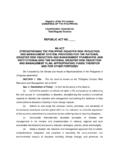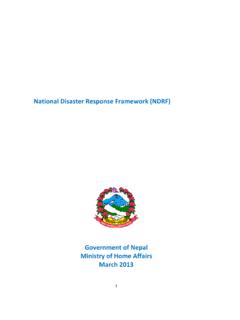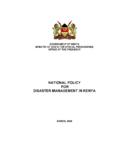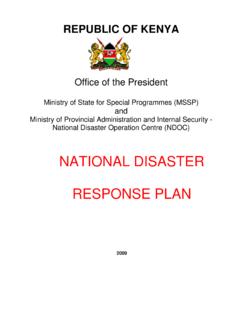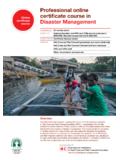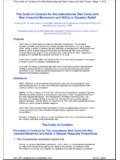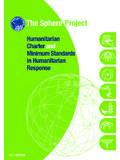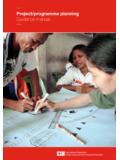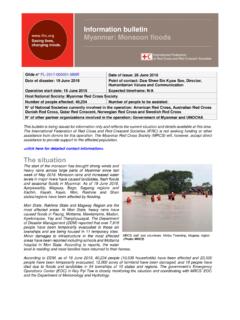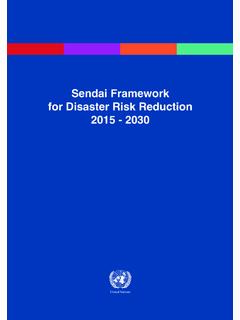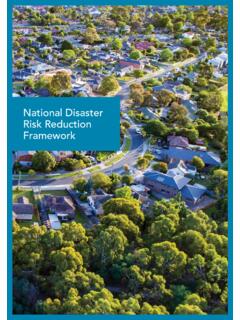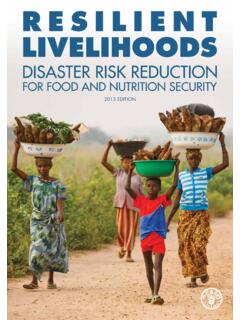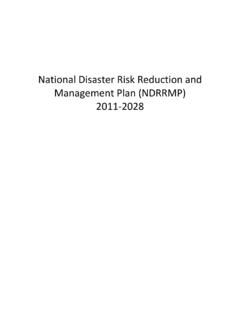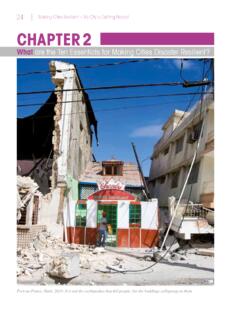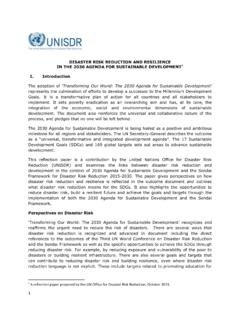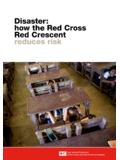Transcription of Disaster management and risk reduction: strategy and ...
1 1 Disaster management and risk reduction : strategy and coordination Executive summary The International Federation needs to have the capacity to mitigate against, prepare for and respond to disasters worldwide and across all levels household, community, national, regional and international. In this, the International Federation is committed to achieving its Global Agenda Goal 1: to reduce the numbers of deaths, injuries and impact from disasters and to the three strategic aims of strategy 2020: 1: Save lives, protect livelihoods, and prepare for and recover from disasters and crises 2: Enable healthy and safer living 3: Promote social inclusion and a culture of non-violence In line with the policy framework established under strategy 2020, the Disaster management and risk reduction global plan for 2010-11 is informed by a cross-sector approach and plans, which prioritize interventions and expected outcomes in the following sectors and areas: Community preparedness and risk reduction Disaster services Shelter and settlement Logistics DREF The Disaster management and risk reduction .
2 strategy and coordination plan does not only provide the framework for the specific sector plans listed above, but also focuses on the delivery of initiatives of a global nature and scope. These initiatives intend to address identified gaps in the way we manage information and knowledge across sectors, as well as supporting funding for community resilience interventions and other DM interventions. With the establishment of decentralized DM functions at regional level (Zone offices), it is essential to provide adequate technical support, information management and coordination capacity globally in support of regional and country level staff as well as National Societies by using innovative methods and approaches that can respond to developing external trends and better enable the zones to respond to the needs of National Societies.
3 This plan seeks CHF (USD or EUR ) in 2010-2011 (Click here to go directly to the summary budget of the plan). Context The increasing frequency of disasters, coupled with a number of emerging threats and trends, are leaving more people vulnerable to the effects of disasters and inflicting greater damage, loss, and dislocation on vulnerable people worldwide. According to the Centre for Research on the Epidemiology of Disasters (CRED), in 2008, more than 235,000 people were killed by disasters, million affected, while the cost of disasters was over 190 billion US$. 2 While the number of disasters recorded in 2008 was lower than 2007, over recent years there has been an increase in the number of small and medium scale disasters, especially storms, floods and epidemics, which National Red Cross and Red Crescent Societies respond to under their mandate as auxiliaries to the public authorities.
4 The first half of 2009 saw a continuation of this trend, with the Red Cross Red Crescent responding to a high number of smaller-scale, local level disasters. The situation of vulnerable people is now aggravated by evolving, complex threats such as climate change, new patterns of marginalisation, demographic growth and a rising proportion of older people, unplanned urbanisation, high levels of violence, involuntary migration, emerging infectious disease and the growing burden of non-communicable disease, environmental degradation, and insecurity of access to food, water, and natural resources. The humanitarian sector is further challenged by of the recent financial crisis and the increasing involvement of military and political actors in humanitarian response.
5 The complexity of the humanitarian environment has led to demands for improved coordination. At the same time, improved forecasting and technology for early warning call for improvements in our capacity for early action and for information management in disasters. There are also calls for greater innovation and more inclusive ways of delivering assistance, with a strong focus on accountability, good partnership and good donorship. All of the above reinforces the need for a strong International Federation, flexible enough to adapt to a fast changing world. In this context, the International Federation needs to have the capacity to mitigate, prepare for and respond to disasters worldwide and across all levels household, community, national, regional and international.
6 The International Federation is committed to achieving its Global Agenda Goal 1: to reduce the numbers of deaths, injuries and impact from disasters and to the three strategic aims of strategy 2020: 1: Save lives, protect livelihoods, and prepare for and recover from disasters and crises 2: Enable healthy and safer living 3: Promote social inclusion and a culture of non-violence The International Federation, and the National Societies as auxiliary to the public authorities, are among the leading providers of assistance globally and are responsible to provide relief to people affected by Disaster . Depending on their capacity to respond and the scale of the Disaster , National Societies can call upon international assistance through the International Federation s secretariat.
7 The International Federation secretariat is committed to ensuring the institutional capacity in preparedness for response, response and recovery to provide that support in a timely manner. The secretariat has a constitutional obligation to organise, coordinate, and direct international relief action as a core service to its members and calls upon its membership to provide additional human resources, technical, material and financial assistance to sister societies in affected countries. With the increase in the number of small and medium scale disasters, the work of National Societies to assist communities to mitigate, prepare for or respond to disasters at a local level is an important added value of our Red Cross Red Crescent network.
8 The effects of food insecurity can also be mitigated at local level through long-term community projects supported by National Societies. The Geneva secretariat will provide support to Nationals Societies in building more resilient communities, mitigation and risk reduction , and food security and livelihoods. Geneva headquarters will maintain a strong strategic oversight in all areas of Disaster management . Priorities and current work with partners In line with the policy framework established under strategy 2020, the Disaster management and risk reduction global plan for 2010-11 is informed by a cross-sector approach and plans which practices, policy guidance, capacity building activities and operational support are primarily targeted at Zone, regional and country offices, as well as at the National Red Cross and Red Crescent Societies they serve within their respective regions.
9 3To ensure the delivery of membership services to National Societies through the Zone network, thus contributing to reduce vulnerabilities to disasters through the development and effective use of capacities and resources, the plans will prioritize interventions in the following sectors and areas: Community preparedness and risk reduction (see plan) Countries at high risk of natural hazards, food security and climate change will be identified, facilitating more targeted support to more communities. Risk reduction opportunities will also be further integrated into this support. Community awareness and understanding of Disaster risk reduction and climate change adaptation will be promoted; the potential actions to reduce the risks will be identified and developed; and the capacity to promote a culture of safety and resilience and preparedness will be built.
10 As part of the Global Alliance on Disaster Risk reduction , vulnerable communities in at least 30 countries will have integrated long-term strategies for increasing their safety and resilience to Disaster and climate risks and National Societies will be encouraged to develop partnerships in support of Disaster Risk reduction and Climate Change Adaptation. As part of the Africa Food Security Initiative, at least 30 National Societies will have scaled-up integrated community-based food security and/or livelihoods programming and have the structures and capacities to contribute to the reduction of chronic and transitory food insecurity National Societies capacities will be strengthened in monitoring and analysing vulnerability to inform their strategic planning, preparedness and improved service delivery to at-risk communities.
